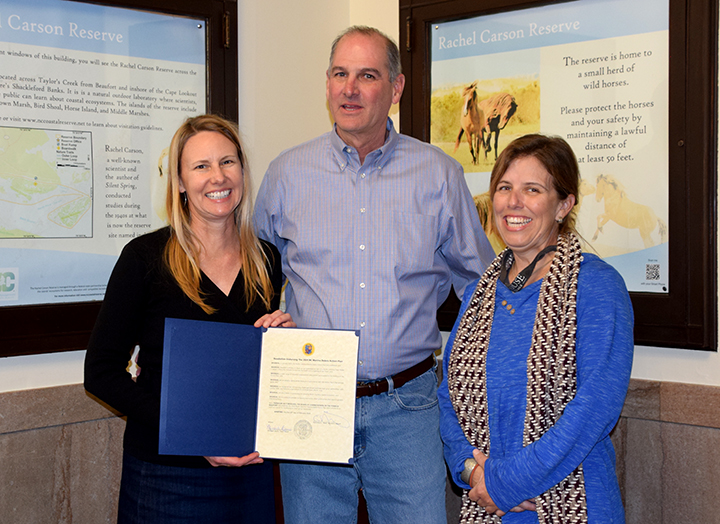
BEAUFORT – This Carteret County town has worked with state, county and federal partners and organizations in recent years to remove litter from its waterways, but officials here have recently taken another step toward the cleanup by endorsing a new, collaborative plan to address the marine debris problem.
As rain drenched the town Monday, about two dozen ducked into the visitor entryway of Beaufort’s town hall to hear Mayor Rett Newton read aloud a proclamation adopted Monday in support of the 2020 North Carolina Marine Debris Action Plan that was released in January.
Supporter Spotlight
The plan was initiated in 2017 by the North Carolina Coastal Federation and is a collaborative effort with the North Carolina Coastal Reserve and National Estuarine Research Reserve, North Carolina Sea Grant, Onslow County Solid Waste and North Carolina Marine Debris Symposium. It was developed to provide a framework for the next five years to “strategically reduce the amount of marine debris and its impacts in coastal North Carolina through tangible and measurable actions.”
In an email announcing the event, Newton explains that Beaufort is the first community to actively endorse and continue to pursue the five goals outlined in the plan, which are leading and coordinating with partners and stakeholders to engage the plan, prevent marine debris, remove debris, prevent and remove abandoned and derelict vessels and conduct research and assessment.
Before reading the proclamation endorsing the plan, Newton noted there were “lots of different people with lots of different interests in marine debris” in attendance. Attendees included representatives from the Coastal Federation, Down East Council, University of North Carolina Institute of Marine Sciences, Carteret County Chamber of Commerce, Cape Lookout National Seashore, Beaufort Board of Commissioners, state Division of Coastal Management, North Carolina Coastal Reserve and National Estuarine Research Reserve and the business community.
Reading from the proclamation, Newton said that the town is working to clean up its waterways “as part of a North Carolina Clean Water Coastal Community initiative to improve the health and prosperity of our town” and is “already taking active measures in accordance with the action plan’s five primary goals.”
The proclamation notes challenges ahead but also acknowledges the partnership with county, state, and national organizations to continue the effort.
Supporter Spotlight
Coastal Federation Director Todd Miller told attendees that the blueprint outlined in the plan is a proactive, five-year strategy for preventing more marine debris throughout the coastal area as well as cleaning up what’s already out there in more effective ways.
“I think we all realize after the recent hurricanes just how far behind the eight ball we were in terms of really dealing with this problem, and this is trying to get out ahead of it,” Miller said.
With the town’s proclamation, Miller said he was hopeful for a new tidal wave of local government support for the effort. “This is important not only to the people that come visit this area, but it’s important to the residents that we have an environment that’s safe and good for the wildlife and the people that are here.”
Newton said that after the town’s cleanup that followed Hurricane Florence in September 2018, “where we pulled up 11 derelict vessels, 120,000 pounds of marine debris, 34 illegal moorings, seven car tires, we want to continue to clean up our waterways. And this North Carolina marine debris plan gives us the structure to be able to do this.
“This has taken years to compile and we greatly appreciate the Coastal Federation, Department of Coastal Management, the North Carolina Coastal Reserve, the waterkeepers and all the other partners part of putting this action plan together. And so, this is a really great step,” he continued. “This is really important because the current, vast amount of debris going into our waterways, it’s bad for public health. It’s bad for ecosystem health, and it’s bad for commerce. So, we need to reverse this. And it’s going to take all of us to do this.”
Paula Gillikin, central sites manager for the North Carolina Coastal Reserve & National Estuarine Research Reserve, has been in on the effort with the Coastal Federation since the plan’s beginning. Gillikin has been battling marine debris at the Rachel Carson Reserve in Beaufort since she became the site manager more than 10 years ago.
The N.C. Coastal Reserve & National Estuarine Research Reserve is part of the state Department of Environmental Quality’s Division of Coastal Management. The network of 10 protected sites was established for long-term research, education and stewardship.
Gillikin told Coastal Review Online that marine debris is one of the top management issues for the Rachel Carson Reserve, and that it was also a problem for other sites, including the Wilmington area’s Masonboro Island Reserve and Zeke’s Island National Reserve.
She said reserve officials started learning from partners and through research they were conducting that big items, such as sections of docks, were washing up and smothering the marshes, potentially killing them. While marshes can revegetate, it takes time, during which organisms lose their natural habitats.
Having town support for the plan “feels surreal,” Gillikin said, likening the approval to a gold-star achievement. She said the support can largely be attributed to “a really careful” strategic process.
“It felt like we were going at a snail’s pace at times but that was by design: Slow down to speed up your effectiveness at the end of the day. We started out exploring the issues early and understanding who was involved and then trying to think of how we would address it with others.”









